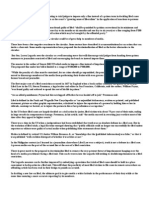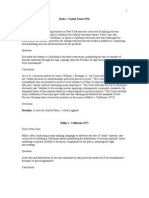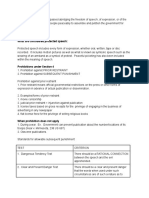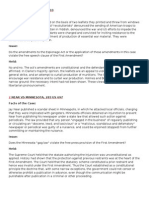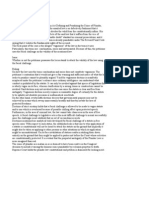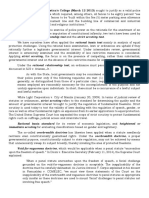Libel Case Codes
Libel Case Codes
Uploaded by
Gabriel UyCopyright:
Available Formats
Libel Case Codes
Libel Case Codes
Uploaded by
Gabriel UyOriginal Description:
Copyright
Available Formats
Share this document
Did you find this document useful?
Is this content inappropriate?
Copyright:
Available Formats
Libel Case Codes
Libel Case Codes
Uploaded by
Gabriel UyCopyright:
Available Formats
Libel/Tort
1. NY Times vs. Sullivan
o The Court held that the First Amendment protects the publication of all statements,
even false ones, about the conduct of public officials except when statements are
made with actual malice (with knowledge that they are false or in reckless
disregard of their truth or falsity). Under this new standard, Sullivan's case
collapsed.
2. Vasquez vs. CA
o Even if the defamatory statement is false, no liability can attach if it relates to official
conduct, unless the public official concerned proves that the statement was made
with actual malice—that is, with knowledge that it was false or with reckless
disregard of whether it was false or not
3. Hustler Magazine vs. Falwell
o In order to protect the free flow of ideas and opinions on matters of public interest
and concern, public figures and officials may NOT recover for the tort of intentional
infliction of emotional distress by reason of publication without showing in addition
that the publication contains a false statement of fact which was made with
“actual malice”, i.e. with knowledge that it was false or with reckless disregard of
whether it was false or not. This standard is necessary to give adequate breathing
space to the freedoms protected by the 1st amendment.
4. Newsweek vs. IAC
o Where the defamation is alleged to have been directed at a group or a class, it is
essential that the statement must be so sweeping or all-embracing as to apply to
every individual in that group or class, or sufficiently specific so that each individual
in the class or group can prove that the defamatory statement specifically pointed to
him, so that he can bring the action separately, if need be.
5. Beauharnais vs. Illinois
o The State of Illinois cannot be denied of the power to punish utterance directed at a
defined group, unless the utterance is a willful and purposeless restriction unrelated
to the peace and well-being of the State.
6. MVRS Publications vs. Islamic Da’wah Council of the Philippines
o Group libel does NOT give rise to a cause of action on the part of an individual unless
it can be shown that he is the target of the defamatory matter. In this case, the
group was so large that: (1) No reasonable reader would take the statements as so
literally applying to each individual member; and (2) Limitation on liability would
safeguard freedom of speech and expression.
o (Dissent) The case is not about libel but about tortious conduct. The offensive act
need not identify the plaintiff as the object of humiliation. What is important is to
prove that the plaintiff suffered mental and emotional distress because of what he
read, saw and that the statement is given to a group for which he belongs.
7. SC Administrative Circular No. 08-2008
Compelled Speech
1. Red Lion Broadcasting Co. vs. FCC
Subsequent decisions of FCC laid down a two-fold policy: (1) Personal attack doctrine
– When a personal attack has been made on a figure involved in a public issue, it is
required that the individual attacked must be offered an opportunity to respond;
and (2) Fairness doctrine – Issues must be presented with coverage of competing
views. It must be ensured that both sides are presented.
It is the right of the viewers and listeners, and NOT the right of the broadcasters
which is paramount. The First Amendment seeks to preserve an uninhibited
marketplace of ideas. It is the right of the public to receive suitable access to social,
political, aesthetic, moral and other ideas and experiences which is crucial here. This
right may not be abridged by the Congress or FCC.
2. Miami Herald Publishing Co. vs. Tornillo
Florida's “right of reply” statute violated the First Amendment. The right of reply
law restricted the Miami Herald's free speech because it prevented the newspaper
from saying whatever else it wanted. The law “exacts a penalty on the basis of the
content” of the paper. The penalty would be the time, materials, and newspaper
space required to publish a candidate's reply. As a result, “editors might well
conclude that the safe course is to avoid controversy. Therefore…political and
electoral coverage would be blunted or reduced.”
3. Turner Broadcasting System, Inc. vs. FCC
The must-carry provisions were designed to serve three interrelated, important
governmental interests:
i. Preserving the benefits of free, over-the-air local broadcast televisions;
ii. Promoting the widespread dissemination of information from a multiplicity
of sources; and
iii. Promoting the fair competition in the television programming market
The must-carry provisions do not burden substantially more speech than is
necessary to further the governmental interest they promote.
Overbreadth and Void-for-Vagueness
1. Estrada vs. Sandiganbayan
The vagueness and overbreadth doctrines only apply to free speech cases. The
theory is that a facial challenge is allowed for vague and overbroad statutes because
of its possible “chilling effect” on protected speech. The possible harm to society in
permitting some unprotected speech to go unpunished is outweighed by the
possibility that the protected speech of others may be deterred, and grievances left
to fester because of the inhibitory effect. The same rationale does not apply to penal
statutes precisely because criminal statutes are meant to have an “in terrorem”
effect. In a facial challenge is allowed for this reason, then we may just as well not
enact penal laws.
Vagueness and overbreadth challenges in the free speech context typically
produce facial invalidation, while statutes found vague as a matter of due process
are typically invalidated only “as applied” to a particular defendant.
2. David vs. GMA
Overbreadth doctrine is NOT applicable. First, it is an analytical tool developed for
testing “on their faces” statutes in free speech cases. PP 1017 is not primarily
directed to speech or even speech-related conduct. Second, facial invalidation of
laws is considered manifestly strong medicine, to be used “sparingly and only as a
last resort” and is “generally disfavored”. Last, a facial challenge on the ground of
overbreadth is the most difficult challenge to mount successfully, since the
challenger must establish that there can be no instance when the assailed law may
be valid.
Void-for-vagueness is also NOT applicable.
Sexually Explicit Expression
1. Pita vs. CA
Useless case.
Under the Clear and Present Danger test, the Government has not discharged the
burden of proof required to justify a ban and to warrant confiscation of the
literature. They were not possessed of a lawful court order: (1) finding the materials
to be pornography; and (2) authorizing them to carry out a search and seizure by
way of a search warrant.
Steps in confiscating materials:
o Apply for issuance of search warrant.
o Determine the materials that are obscene and pose Clear and Present
Danger.
o The judge will determine whether or not the materials are obscene (case-to-
case basis and upon sound discretion).
o If there is a probable cause, issue the search warrant.
2. Gonzales vs. Kalaw-Katigbak
Another useless case.
The test to be used is: WON to the average person, applying contemporary
community standards, the dominant theme of the material taken as a whole appeals
to prurient interest.
3. People vs. Padan
An actual exhibition of the sexual act, preceded by acts of lasciviousness has no
redeeming feature. There is no room for art in it. One can see nothing in it but clear
and unmitigated obscenity, indecency, and an offense to public morals, inspiring and
causing as it does, nothing but lust and lewdness, and exerting a corrupting
influence specially on the youth of the land.
4. People vs. Kottinger
Pictures which depict the non-Christian inhabitants as they actually live, without
attempted presentation of them in unusual posture or dress, are not offensive to
chastity, or foul or filthy. The aggregate judgment of the Philippine community
would not be shocked by photographs of this type.
5. Miller vs. California
Obscene material can be regulated by the State, subject to these guidelines:
i. Whether the average person, applying contemporary community standard
would find that the work, taken as a whole, appeals to prurient interest;
ii. Whether the work depicts or describes, in a patently offensive way, sexual
conduct specifically defined by the applicable state law;
iii. Whether the work, taken as a whole, lacks serious literary, artistic, political,
or scientific value.
6. Paris Adult Theater I vs. Slaton
The state has legitimate interest in regulating commercialized obscenity in public
places, even assuming it is feasible to enforce safeguards against exposure to
juveniles and passerby. It has the power to make a morally neutral judgment that
the public exhibition or commerce of such obscene material has a tendency to injure
the community as a whole, to endanger public safety or to jeopardize the right to
maintain a decent society.
7. Ashcroft vs. Free Speech Coalition
The Child Pornography Prevention Act (CPPA) prohibits speech despite its serious
literary, artistic, political or scientific value. If films etc., contain a single graphic
depiction of sexual activity within the statutory definition, the possession of the film
would be subject to severe punishment without inquiry into the work’s redeeming
value. For this reason, CPPA cannot be read to prohibit obscenity because it lacks
the required link between its prohibitions and the affront to community standard
prohibited by the definition of obscenity.
8. Schad vs. Mount Ephraim
When a zoning law infringes upon a protected liberty, it must be narrowly drawn
and must further a sufficiently substantial government interest. The Court must not
only assess the substantiality of the governmental interests asserted but also
determine whether those interests could be served by means that would be less
intrusive on activity protected by the First Amendment.
9. American Booksellers Association vs. Hudnut
The ordinance impermissibly discriminates on the basis of point of view
(pornography as a practice that discriminates against women). It discriminates on
the ground of the content of the speech. Speech treating women in the approved
way- in sexual encounters premised on equality, is lawful no matter how sexually
explicit. Speech treating women in the disapproved way- as submissive in sexual
matters or as enjoying humiliations- is unlawful no matter how significant the
literary, artistic, or political qualities of the work taken as a whole.
10. FCC vs. Pacifica Foundation
The Court has never held that prurient appeal is an essential component of indecent
language. Prurient appeal is an element of obscene, while indecent normally
pertains to nonconformance with accepted standards of morality.
The content of the broadcast was vulgar, offensive and shocking. It is not entitled to
absolute constitutional protection. Moreover, broadcasting is uniquely accessible to
children and one broadcast is all that is necessary to affect them. Hence, the
government’s interest in protecting the well-being of the youth and in supporting
the claims of parents to authority in their own household justified the regulation
of expression otherwise protected.
11. Ashcroft vs. American Civil Liberties Union
If the audience is comprised of different communities with different local
standards, the defendant bears the burden of complying with the prohibition on
obscene messages. Because Congress has narrowed the range of content restricted
by COPA (Child Online Protection Act) in a manner analogous to Miller’s definition of
obscenity, the Court conclude that any variance caused by that statute’s reliance on
community standards is not substantial to violate the First Amendment.
You might also like
- CCEA Files Lawsuit Against Nevada Law That Bans Government Employees From StrikingDocument10 pagesCCEA Files Lawsuit Against Nevada Law That Bans Government Employees From Striking8 News NowNo ratings yet
- Con Law II - Case Flow ChartDocument5 pagesCon Law II - Case Flow ChartBrittany Johnson100% (1)
- Romualdez V COMELEC G.R. No. 167011 April 30, 2008Document3 pagesRomualdez V COMELEC G.R. No. 167011 April 30, 2008John Yeung0% (1)
- Media Law and Ethics Midterm ReviewDocument3 pagesMedia Law and Ethics Midterm ReviewJoeNo ratings yet
- Defenses - LibelDocument7 pagesDefenses - LibelBey VillanuevaNo ratings yet
- Criminal Law 1 Case DigestDocument201 pagesCriminal Law 1 Case DigestMary Boaquiña80% (5)
- Civil Liberties ReviewerDocument7 pagesCivil Liberties Reviewergem_mataNo ratings yet
- Free Speech vs. DefamationDocument5 pagesFree Speech vs. DefamationAdv Sneha SolankiNo ratings yet
- Freedom of Expression NotesDocument28 pagesFreedom of Expression NotesLaserNo ratings yet
- Lecture Notes On Constitutional Law 2Document10 pagesLecture Notes On Constitutional Law 2Sarah Jade LayugNo ratings yet
- Freedom From Subsequent PunishmentDocument13 pagesFreedom From Subsequent PunishmentRose Ann RayoNo ratings yet
- Huaming Li - 2021 - Law - 2nd PlaceDocument5 pagesHuaming Li - 2021 - Law - 2nd PlaceShobha SinghNo ratings yet
- DoctrinesDocument26 pagesDoctrinesSelynn CoNo ratings yet
- Consti Finals ReviewerDocument18 pagesConsti Finals ReviewerRALPH CORTESNo ratings yet
- Bill of Rights NotesDocument17 pagesBill of Rights NotesSIBAYAN, ZANEA AYNNo ratings yet
- Restraint, The Author Zeroes in On The Difference Between Prior Restraint and SubsequentDocument3 pagesRestraint, The Author Zeroes in On The Difference Between Prior Restraint and SubsequentChey DumlaoNo ratings yet
- I. Free Speech: A General Overview and Key Concepts A. Our Speech System & ExplanationsDocument53 pagesI. Free Speech: A General Overview and Key Concepts A. Our Speech System & ExplanationsfgsdfNo ratings yet
- Freedom of ExpressionDocument11 pagesFreedom of ExpressionMaria CarlinaNo ratings yet
- Guingguing vs. People, G.R. No. 128959. Sept. 30, 2005Document3 pagesGuingguing vs. People, G.R. No. 128959. Sept. 30, 2005AnneNo ratings yet
- Estrada v. Escritor 455 Phil. 411 2003 CDDocument6 pagesEstrada v. Escritor 455 Phil. 411 2003 CDAubrey AquinoNo ratings yet
- Freedom of Expression ReviewerDocument10 pagesFreedom of Expression ReviewerIvan Luzuriaga100% (1)
- Tort AssignmentDocument8 pagesTort AssignmentTanya Tandon100% (1)
- Defamation Law (Replaces Both Pre and Post 2006 Versions)Document16 pagesDefamation Law (Replaces Both Pre and Post 2006 Versions)Matthew TungpalanNo ratings yet
- Respondents 3 - (Counsels For Amicus Curiae in Favor of The Government) Issues: 1 and 4Document21 pagesRespondents 3 - (Counsels For Amicus Curiae in Favor of The Government) Issues: 1 and 4dollyccruzNo ratings yet
- Using Privileged Communication As A Defense To Libel: Attorneys of The Philippines Legal NewsDocument29 pagesUsing Privileged Communication As A Defense To Libel: Attorneys of The Philippines Legal NewsJoel C Agra100% (1)
- Civil Defamation PDFDocument12 pagesCivil Defamation PDFHorace Prophetic DavisNo ratings yet
- CONSTI 2 ReviewerDocument3 pagesCONSTI 2 ReviewerCARLYLE JANINE CHUANo ratings yet
- Libel DefensesDocument7 pagesLibel DefensesRb TumbagaNo ratings yet
- Bill of RightsDocument14 pagesBill of RightsmshenilynNo ratings yet
- FirstAmendmentOutline OlsonDocument33 pagesFirstAmendmentOutline OlsonAJ SharmaNo ratings yet
- HURL Group 5 - Violation of The Freedom of The Press (Faelmarin, Macapagal, Mappatao)Document12 pagesHURL Group 5 - Violation of The Freedom of The Press (Faelmarin, Macapagal, Mappatao)JD 1-6 Books MaterialsNo ratings yet
- Freedom of Artistic Expression: Examining Blasphemous Artworks in Public MuseumsDocument18 pagesFreedom of Artistic Expression: Examining Blasphemous Artworks in Public Museumsvanessa hernandezNo ratings yet
- Constitutional Law Finals NotesDocument18 pagesConstitutional Law Finals NotesJether CorpuzNo ratings yet
- MGMT 260 CH 5 SL PT IDocument17 pagesMGMT 260 CH 5 SL PT IqhaweseithNo ratings yet
- Study GuideDocument46 pagesStudy Guidesjs8906100% (1)
- Do We Have A Right To Pornography (Ronald Dworkin)Document20 pagesDo We Have A Right To Pornography (Ronald Dworkin)Fabrizio Perez Téllez RamírezNo ratings yet
- 04 GONZALES Vs KATIGBAKDocument3 pages04 GONZALES Vs KATIGBAKq.kimheartNo ratings yet
- Crim Cases 2EDocument40 pagesCrim Cases 2ESophia Mae SungcogNo ratings yet
- Legal Theory 1B Final Paper of Franco Luis G. LopezDocument10 pagesLegal Theory 1B Final Paper of Franco Luis G. LopezLuis LopezNo ratings yet
- Obscenity. Students Free Speech. AssemblyDocument5 pagesObscenity. Students Free Speech. AssemblyAnaliza AlcoseroNo ratings yet
- CHAVEZ VS GONZALES - Case DigestsDocument7 pagesCHAVEZ VS GONZALES - Case DigestsJosine ProtasioNo ratings yet
- Guingguing v. People, G.R. No. 128959, 30 September 2005.Document3 pagesGuingguing v. People, G.R. No. 128959, 30 September 2005.Albert RoseteNo ratings yet
- Tort Assignment Defamation FinalDocument12 pagesTort Assignment Defamation FinalKimberly Mwansa MushotaNo ratings yet
- Week 7-8Document6 pagesWeek 7-8Flash ehimplarNo ratings yet
- Assignment 2 TortDocument12 pagesAssignment 2 TortKimberly Mwansa MushotaNo ratings yet
- Consti2 Cases Quick NotesDocument11 pagesConsti2 Cases Quick NotesClariza ReyesNo ratings yet
- Borjal v. CADocument36 pagesBorjal v. CAalexis_beaNo ratings yet
- Notes On Civil Liberties (Secs. 4 - 10 - 18 & 20)Document47 pagesNotes On Civil Liberties (Secs. 4 - 10 - 18 & 20)John Ethelred OsabelNo ratings yet
- Gonzalez v. KatigbakDocument2 pagesGonzalez v. KatigbakRon AceNo ratings yet
- Friendly Realtion of StatesDocument4 pagesFriendly Realtion of StatesHarsh DixitNo ratings yet
- What Are Considered Protected SpeechDocument5 pagesWhat Are Considered Protected SpeechDreNo ratings yet
- Consti Cases - Freedom of Expression - 1 To 10Document8 pagesConsti Cases - Freedom of Expression - 1 To 10Hanna MapandiNo ratings yet
- Attorneys and Admission To BarDocument6 pagesAttorneys and Admission To BarearthmaverickNo ratings yet
- Limitations On The Freedom of ExpressionDocument10 pagesLimitations On The Freedom of ExpressionLois DNo ratings yet
- Babst vs. National Intelligence BoardDocument45 pagesBabst vs. National Intelligence BoardIyaNo ratings yet
- Criticisms of Official ConductDocument69 pagesCriticisms of Official Conductjake31No ratings yet
- Millhiser-First Amendment OutlineDocument45 pagesMillhiser-First Amendment OutlineDavidFriedman100% (1)
- CASE DIGEST: U.S. V Bustos: FactsDocument3 pagesCASE DIGEST: U.S. V Bustos: Factssprokonoinoi100% (1)
- Assignement 2Document28 pagesAssignement 2Sample BakeshopNo ratings yet
- Conviction Machine: Standing Up to Federal Prosecutorial AbuseFrom EverandConviction Machine: Standing Up to Federal Prosecutorial AbuseRating: 3.5 out of 5 stars3.5/5 (3)
- Service To DPWH Laws and JurisprudenceDocument5 pagesService To DPWH Laws and JurisprudenceGabriel UyNo ratings yet
- Commissioner Verification Survey JurisprudenceDocument3 pagesCommissioner Verification Survey JurisprudenceGabriel UyNo ratings yet
- Accounting BasicsDocument2 pagesAccounting BasicsGabriel UyNo ratings yet
- Affid of Service SampleDocument1 pageAffid of Service SampleGabriel UyNo ratings yet
- Interest Rate JurisprudenceDocument2 pagesInterest Rate JurisprudenceGabriel UyNo ratings yet
- Alteration of Title JurisprudenceDocument24 pagesAlteration of Title JurisprudenceGabriel UyNo ratings yet
- Case Digest Liban V GordonDocument2 pagesCase Digest Liban V GordonGabriel UyNo ratings yet
- Suhuri v. Commission On ElectionsDocument9 pagesSuhuri v. Commission On ElectionsGabriel UyNo ratings yet
- Lim V VianzonDocument2 pagesLim V VianzonGabriel UyNo ratings yet
- Bautista Copy PasteDocument1 pageBautista Copy PasteGabriel UyNo ratings yet
- Ocampo Vs COADocument18 pagesOcampo Vs COAGabriel UyNo ratings yet
- Clear and Present Danger Test: Advocacy of Illegal ActionDocument98 pagesClear and Present Danger Test: Advocacy of Illegal ActionDavid YergeeNo ratings yet
- 07 Southern Hemisphere V Anti Terrorism - LauretaDocument2 pages07 Southern Hemisphere V Anti Terrorism - LauretaIsay YasonNo ratings yet
- Estrada Vs Sandiganbayan DigestDocument4 pagesEstrada Vs Sandiganbayan DigestJoseph Denila LagunaNo ratings yet
- Memo 1Document26 pagesMemo 1Varun OberoiNo ratings yet
- Case Digest David V ArroyoDocument2 pagesCase Digest David V ArroyoYanie Sajor QuintoNo ratings yet
- Bar 2022 - Political Law Part I - by Alexis F. Medina - Recoletos Law Center v3Document39 pagesBar 2022 - Political Law Part I - by Alexis F. Medina - Recoletos Law Center v3cyrus dresselhausNo ratings yet
- Constitutional Law II Reviewer - ADDU (2017)Document70 pagesConstitutional Law II Reviewer - ADDU (2017)Jackelyn GremioNo ratings yet
- Estrada Vs SandiganbayanDocument2 pagesEstrada Vs SandiganbayanDianne Camille UyNo ratings yet
- Estrada v. Sandiganbayan, GR No. 148560Document84 pagesEstrada v. Sandiganbayan, GR No. 148560lee viceNo ratings yet
- Samahan NG Mga Progresibong Kabataan v. Quezon City PDFDocument63 pagesSamahan NG Mga Progresibong Kabataan v. Quezon City PDFAdrianNo ratings yet
- Police PowerDocument2 pagesPolice PowerMarvin CabantacNo ratings yet
- Southern Hemisphere Engagement Network, Inc. V Anti-Terrorism CouncilDocument3 pagesSouthern Hemisphere Engagement Network, Inc. V Anti-Terrorism CouncilMa. Francesca GerolagaNo ratings yet
- United States Court of Appeals, Second Circuit.: No. 328, Docket 35287Document9 pagesUnited States Court of Appeals, Second Circuit.: No. 328, Docket 35287Scribd Government DocsNo ratings yet
- 22 - SPARK Vs QCDocument2 pages22 - SPARK Vs QCJohn Robert Bautista100% (1)
- Atty Sandoval Notes Constitutional Law Political Law 2Document204 pagesAtty Sandoval Notes Constitutional Law Political Law 2Bec Bec BecNo ratings yet
- INTERACTIVE MEDIA ENTERTAINMENT AND GAMING ASSOCIATION, INC. v. ATTORNEY GENERAL OF THE UNITED STATES Et Al - Document No. 20Document29 pagesINTERACTIVE MEDIA ENTERTAINMENT AND GAMING ASSOCIATION, INC. v. ATTORNEY GENERAL OF THE UNITED STATES Et Al - Document No. 20Justia.comNo ratings yet
- Spark Vs Quezon CaseDocument26 pagesSpark Vs Quezon CaseNathalie YapNo ratings yet
- Estrada V Sandiganbayan 369 SCRA 394Document16 pagesEstrada V Sandiganbayan 369 SCRA 394graceNo ratings yet
- G.R. No. 223705 - LOIDA NICOLAS-LEWIS, PETITIONER, v. COMMISSION ON ELECTIONS, RESPONDENT - August 2019 - Philipppine Supreme Court DecisionsDocument45 pagesG.R. No. 223705 - LOIDA NICOLAS-LEWIS, PETITIONER, v. COMMISSION ON ELECTIONS, RESPONDENT - August 2019 - Philipppine Supreme Court DecisionsAaron James PuasoNo ratings yet
- David Et Al Vs ErmitaDocument3 pagesDavid Et Al Vs ErmitaRoss LyneNo ratings yet
- Facial Challenge VDocument15 pagesFacial Challenge VFelizardo I RomanoNo ratings yet
- Consti2 ReviewerDocument26 pagesConsti2 ReviewerLouis Malaybalay100% (1)
- Coates v. Cincinnati, 402 U.S. 611 (1971)Document8 pagesCoates v. Cincinnati, 402 U.S. 611 (1971)Scribd Government DocsNo ratings yet
- G.R. No. 225442Document28 pagesG.R. No. 225442Mark Angelo DayagNo ratings yet
- Allan Madrilejos, Allan Hernandez, Glenda Gil, and Lisa Gokongwei-Cheng, Petitioners, VSDocument17 pagesAllan Madrilejos, Allan Hernandez, Glenda Gil, and Lisa Gokongwei-Cheng, Petitioners, VSJehnn Audrie BenitoNo ratings yet
- SPARK v. QCDocument23 pagesSPARK v. QCAngelo Brian Kiks-azzNo ratings yet
- Due Process - Impartial and Competent CourtDocument8 pagesDue Process - Impartial and Competent CourtEmNo ratings yet



























